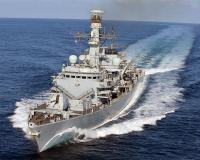 Naval ships are very expensive to build and operate and in the best of all possible worlds would never be used. Nevertheless, they exist for a purpose. Recently, while taking part in commemorations for the Battle of Jutland centenary, HMS Kent intercepted a Russian submarine as it cruised towards the English Channel. It was reported that the Stary Oskol, a Kilo-class submarine capable of carrying cruise missiles and torpedoes, was first detected by NATO forces in the North Sea. HMS Kent escorted the submarine past the Strait of Dover on Wednesday morning.
Naval ships are very expensive to build and operate and in the best of all possible worlds would never be used. Nevertheless, they exist for a purpose. Recently, while taking part in commemorations for the Battle of Jutland centenary, HMS Kent intercepted a Russian submarine as it cruised towards the English Channel. It was reported that the Stary Oskol, a Kilo-class submarine capable of carrying cruise missiles and torpedoes, was first detected by NATO forces in the North Sea. HMS Kent escorted the submarine past the Strait of Dover on Wednesday morning.
Russian submarine patrols are reported to have increased by around 50% over the last year. Britain is facing a particular challenge as they scrapped their submarine-hunting Nimrod maritime patrol aircraft in 2010 in a cost-cutting measure. Last November the British called upon French patrol planes to assist in the search for a Russia submarine believed to be operating off Scotland.
Britain is also facing a shortage of ships. HMS Kent is a Type 23 Duke class frigate, one of 13 in the Royal Navy, which were commissioned between 1990 and 2004. The Royal Navy also operates six Class 45 destroyers, which have suffered reliability problems when operating in the Gulf. A program to replace the Type 23 frigates with a next generation Type 26 frigate was supposed to deliver the first new ship in 2020. Now it appears that the entire program will be moved back so that the first ship will not be delivered until 2025. The cause for the delay appears to be financial.
Thanks for Alaric Bond and Antione Vanner for contributing to this post.
